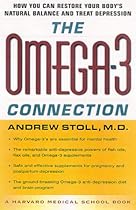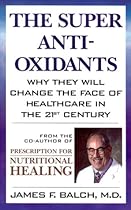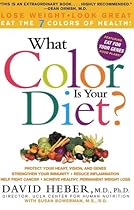| The list of phytochemicals is endless and grows daily as researchers uncover more of these health-enhancing plant nutrients. (See The Anti-Cancer Army in Vegetables and Fruits below for a list of some of these compounds.)
THE ANTI-CANCER ARMY IN VEGETABLES AND FRUITS
Mother Nature packed nutritional muscle into fruits and vegetables. In addition to hefty doses of antioxidant nutrients such as vitamins C and E and selenium, folic acid, and fiber, vegetables and fruit contain more than 12,000 compounds that boost your body's natural defenses against disease. |
| D, chairman and professor of nutrition at Andrews University in Michigan, "We don't know what an optimal dose is when it comes to phytochemicals, but we do know that the more phytochemical-rich fruits, vegetables, and whole grains you eat, the more protection you get." Based on the ancient diets on which we evolved, most of us should triple our current intakes to approach the level needed to sustain optimal health.
FIBER FITNESS
With our ancestors eating such a wide array of fruits, vegetables, legumes, nuts, and grasses, it's no wonder they consumed at least 100 grams of fiber every day. |
| In an effort to boost the meager nutritional value of our overly processed foods, manufacturers are adding vitamins, minerals, herbs, and phytochemicals to new foods. These nutritionally fortified products are called functional foods, and they are likely to be the foods of the future, for better or for worse. Isolating specific health-enhancing compounds in whole foods, then transferring them to other foods, either by dumping them as additives into processed foods or by genetically altering wholesome foods, is the latest passion of researchers and industry. |
| Supplements, drinks, and energy bars are just the beginning of a wave of high-tech products packed with varying amounts of phytochemicals, probiotics, herbs, vitamins, and antioxidants. Watch this trend with a wary eye and don't be fooled by new products advertised as herb- or phytochemical-fortified mood enhancers, energy boosters, life extenders, or disease fighters. To eat in tune with your evolutionary roots, you're better off sticking with wholesome, unprocessed, real food, which is what your body craves anyway. |
Andrew L. Stoll
See book keywords and concepts |
 Positive synergistic reactions between different phytochemicals in plants may be lost when they are not eaten in plant form. Try to buy or even grow organic foods and naturally raised animal products. Many pesticides are potent and damaging chemicals whose capacity to cause neurological disorders as well as cancer, allergies and hypersensitivity reactions remains under-studied.
Antioxidant Facts
Antioxidants are mentioned frequently in the nutrition and supplement literature. Positive synergistic reactions between different phytochemicals in plants may be lost when they are not eaten in plant form. Try to buy or even grow organic foods and naturally raised animal products. Many pesticides are potent and damaging chemicals whose capacity to cause neurological disorders as well as cancer, allergies and hypersensitivity reactions remains under-studied.
Antioxidant Facts
Antioxidants are mentioned frequently in the nutrition and supplement literature. |
James F. Balch, M.D.
See book keywords and concepts |
 Those factors were selenium, a low-fat diet, green tea, and phytochemicals from cruciferous vegetables like turnips, cabbage, radishes, and horseradish. Also, if one of the key factors in controlling the progress of AIDS is controlling overall oxidative stress, then adding the antioxidant activity of green tea consumption should relieve much of that burden, keeping the disease in check.
Cancer and the Benefits of Green Tea
Most of the current research into green tea has focused on its cancer-fighting ability. Those factors were selenium, a low-fat diet, green tea, and phytochemicals from cruciferous vegetables like turnips, cabbage, radishes, and horseradish. Also, if one of the key factors in controlling the progress of AIDS is controlling overall oxidative stress, then adding the antioxidant activity of green tea consumption should relieve much of that burden, keeping the disease in check.
Cancer and the Benefits of Green Tea
Most of the current research into green tea has focused on its cancer-fighting ability. |
Bill Gottlieb
See book keywords and concepts |
 Have a slice of tomato, and you'll get up to several hundred different phytochemicals, most of which seem to play some role in stopping tumors before they form. To further reduce your risk of oxidation-caused cancers, experts recommend that you thoroughly wash and even peel all fruits and vegetables before eating them to minimize ingesting sprayed-on pesticides.
¦mil
Eating for Immunity
Another bonus offered by fruits and vegetables: They're among the best sources of nutrients needed for a strong immune system, your body's defense against disease. Have a slice of tomato, and you'll get up to several hundred different phytochemicals, most of which seem to play some role in stopping tumors before they form. To further reduce your risk of oxidation-caused cancers, experts recommend that you thoroughly wash and even peel all fruits and vegetables before eating them to minimize ingesting sprayed-on pesticides.
¦mil
Eating for Immunity
Another bonus offered by fruits and vegetables: They're among the best sources of nutrients needed for a strong immune system, your body's defense against disease. |
Michael Tierra
See book keywords and concepts |
 The phytochemicals generated from the concentrated fermented soybean extract are able to prevent cancer by capturing free radicals and prevent them from damaging DNA. In animal studies, they have been found to be effective in the prevention and treatment of most cancers, including breast, colorectal, and prostate. They assist in detoxifying the liver, lowering the number of histamines in the blood to help clear various allergic reactions (including bronchitis and nasal congestion), and also to help relieve pain, lower cholesterol, heal stomach ulcers, and stop menstrual cramps. The phytochemicals generated from the concentrated fermented soybean extract are able to prevent cancer by capturing free radicals and prevent them from damaging DNA. In animal studies, they have been found to be effective in the prevention and treatment of most cancers, including breast, colorectal, and prostate. They assist in detoxifying the liver, lowering the number of histamines in the blood to help clear various allergic reactions (including bronchitis and nasal congestion), and also to help relieve pain, lower cholesterol, heal stomach ulcers, and stop menstrual cramps. |
| The isoflavones are a group of phytochemicals that include genistein. Genistein is an estrogen precursor that binds to receptor sites and either blocks estrogen uptake if there is too much or supplies it if there is too little. This is thought to be why Asian women have a noticeable lack of gynecological problems associated with menopause, fibroids and more than a 45% lower incidence of breast cancer. |
Dr. Vern Cherewatenko and Paul Perry
See book keywords and concepts |
 Here are just a few of the known phytochemicals, food sources, and believed roles in disease prevention.
• Ellagic acid. Common in grapes, strawberries, raspberries, and walnuts, this phytochemical appears to remove cancer-causing agents from the bloodstream.
• Flavonoids. A family of chemicals found in apples, red wine, and tea, flavonoids seem to play a role in cancer and heart disease prevention. They may reduce cancer risk by blocking hormones that create cell changes and by suppressing changes in malignant cells.
Indoles and isothiocyanates. Here are just a few of the known phytochemicals, food sources, and believed roles in disease prevention.
• Ellagic acid. Common in grapes, strawberries, raspberries, and walnuts, this phytochemical appears to remove cancer-causing agents from the bloodstream.
• Flavonoids. A family of chemicals found in apples, red wine, and tea, flavonoids seem to play a role in cancer and heart disease prevention. They may reduce cancer risk by blocking hormones that create cell changes and by suppressing changes in malignant cells.
Indoles and isothiocyanates. |
| Cruciferous vegetables, such as Brussels sprouts, cauliflower, and cabbage, are especially good sources of antioxidant phytochemicals.
Isoflavones. Soybeans contain this phytochemical, along with several other antioxidant substances, including phytic acid, protease inhibitors, saponins, phytoserols, and phenolic acid.
Lignans. Commonly found in oil pressed from flaxseed, lignans is a powerful antioxidant that also contains omega-3 fatty acids that may protect against heart disease and colon cancer.
Monoterpenes. |
| A rich and varied diet containing fruits, vegetables, grains, dairy products and protein also includes fiber and phytochemicals essential for good health. A pill can't come close to supplying all those in the right combination or form, but when used to supplement the diet, appropriate formulas can be very helpful to the body.
Balance is another concern. Good nutation is based on taking in appropriate amounts of vitamins and minerals to act on the calories you eat and burn through exercise. |
Andrew L. Stoll
See book keywords and concepts |
 Richly pigmented fruits and vegetables such as blueberries, cantaloupe, watermelon, and red peppers also provide antioxidant phytochemicals. Tomatoes contain both alpha- and beta-carotene, as well as lycopene, an extremely powerful antioxidant. Even the green herbs rosemary, oregano, and thyme have antioxidant compounds.
Substitute these healthy foods for the processed commercial snacks high in carbohydrates and trans-fatty acids that are so common today. Cut the fruits and vegetables up ahead of time, if possible, so you have something easy to reach for.
Fats and Oils. Richly pigmented fruits and vegetables such as blueberries, cantaloupe, watermelon, and red peppers also provide antioxidant phytochemicals. Tomatoes contain both alpha- and beta-carotene, as well as lycopene, an extremely powerful antioxidant. Even the green herbs rosemary, oregano, and thyme have antioxidant compounds.
Substitute these healthy foods for the processed commercial snacks high in carbohydrates and trans-fatty acids that are so common today. Cut the fruits and vegetables up ahead of time, if possible, so you have something easy to reach for.
Fats and Oils. |
| Olive oil also has phytochemicals that may be beneficial. Buy olive oil in small quantities in opaque containers, because it oxidizes easily when exposed to light and air. Olive oil also contains some omega-6 oils, a smaller amount of omega-3, and some saturated fat.
Canola oil is composed primarily of the monounsaturated erucic acid made from rapeseeds. Among oils it contains the least amount of saturated fat. It is less expensive than olive oil and has a less distinct flavor, which some prefer. |
| Many of these phytochemicals appear to work syner-gistically with each other, but have not been well studied.
By using foods to obtain needed substances, we are absorbing many different and powerful types of antioxidants, such as ly-copene and rosmarnic acid. Vitamin E in the form of gamma-tocopherol is found in soybeans and nuts. Foods that are deeply pigmented contain flavonoids, which are water-soluble and often highly colored antioxidants. |
James F. Balch, M.D.
See book keywords and concepts |
 Named phytochemicals as a group, they consist of thousands of chemicals such as flavonoids, carotenoids, tocopherols, and phenolic acids, each of which has antioxidant properties. Again, these important chemicals are found in the proper amounts and with the appropriate vitamins and minerals in whole, green foods. Live enzymes are also among the chemicals "killed" by processing.
What Can Be Done?
Unfortunately, in our modern American society, for the majority of us whole green vegetables are not a large portion of our diets. Named phytochemicals as a group, they consist of thousands of chemicals such as flavonoids, carotenoids, tocopherols, and phenolic acids, each of which has antioxidant properties. Again, these important chemicals are found in the proper amounts and with the appropriate vitamins and minerals in whole, green foods. Live enzymes are also among the chemicals "killed" by processing.
What Can Be Done?
Unfortunately, in our modern American society, for the majority of us whole green vegetables are not a large portion of our diets. |
Gary Null, Ph.D.
See book keywords and concepts |
 According to the Journal of the American Dietetic Association:
It is the position of the American Dietetic Association (ADA) that specific substances in foods (e.g. phytochemicals as naturally occurring components and functional food components) may have a beneficial role in health as part of a varied diet. The Association supports research regarding the health benefits and risks of these substances. Dietetics professionals will continue to work with the food industry and government to ensure that the public has accurate scientific information in this emerging field. According to the Journal of the American Dietetic Association:
It is the position of the American Dietetic Association (ADA) that specific substances in foods (e.g. phytochemicals as naturally occurring components and functional food components) may have a beneficial role in health as part of a varied diet. The Association supports research regarding the health benefits and risks of these substances. Dietetics professionals will continue to work with the food industry and government to ensure that the public has accurate scientific information in this emerging field. |
David Heber, M.D., Ph.D.
See book keywords and concepts |
 These phytochemicals are just as important as vitamins for optimum health, but are best obtained from a wide variety of fruits and vegetables. Once you have obtained the needed fruits and vegetables and adequate protein, the remainder of your calories can come from carbohydrates and fats. Whole grain cereals and breads are preferable to refined carbohydrate foods, which are easier to eat in large quantities without feeling full. Whole grains also have other health benefits, including improving intestinal function and providing some DNA protectors in the diet. These phytochemicals are just as important as vitamins for optimum health, but are best obtained from a wide variety of fruits and vegetables. Once you have obtained the needed fruits and vegetables and adequate protein, the remainder of your calories can come from carbohydrates and fats. Whole grain cereals and breads are preferable to refined carbohydrate foods, which are easier to eat in large quantities without feeling full. Whole grains also have other health benefits, including improving intestinal function and providing some DNA protectors in the diet. |
| You can make desirable choices that will help protect your DNA by avoiding obesity and overnutrition and taking in adequate amounts of the phytochemicals in fruits and vegetables. |
| These chemicals are called "phytonutrients" or "phytochemicals," and each of these colored compounds works in different ways to protect your genes and your DNA. By making sure you eat a representative of each of these seven color-coded groups of fruits and vegetables every day, you will be meeting the recommendations of many government agencies, including the National Cancer Institute, that you eat five to nine servings of fruits and vegetables every day.
You will be going further to ensure that your body has what it needs to protect your DNA. Not all fruits and vegetables are the same. |
| Similarly, while the banana has no particular phytochemicals to warrant its inclusion in your diet every day, there are only about 100 calories in a small to medium banana. So adding a half banana to mixed fruit for taste is okay, but devouring three or four bananas, or, for that matter, overeating any fruit, can add significantly to your calories for the day.
Myth #9
Peanut Butter Is a Good Source of Protein
Peanuts are legumes, not nuts. They are high in fat, with about 80 percent of their calories coming from fat. |
Kenny Ausubel
See book keywords and concepts |
 In each of the Hoxsey herbs, there are another ten thousand phytochemicals.
"Carbon-based life-forms are very, very intricate, so the molecular mechanisms are very, very deceptive and not at all what they seem to be. Also, we are rapidly reaching the point where we have to confess that we are moving from the realm of chemistry into a marriage of chemistry and particle physics to explain how things stay alive. Show me one person who can design a relatively competent randomized clinical trial and cope with molecular mechanisms that have to do with physics. In each of the Hoxsey herbs, there are another ten thousand phytochemicals.
"Carbon-based life-forms are very, very intricate, so the molecular mechanisms are very, very deceptive and not at all what they seem to be. Also, we are rapidly reaching the point where we have to confess that we are moving from the realm of chemistry into a marriage of chemistry and particle physics to explain how things stay alive. Show me one person who can design a relatively competent randomized clinical trial and cope with molecular mechanisms that have to do with physics. |
Gary Null, Ph.D.
See book keywords and concepts |
 I researched foods high in phytochemicals to balance the body's natural hormone levels. These were given in juice form, which provided higher bioavailability, so that the person doesn't lose nutrients due to poor digestion. Then I considered foods that help to cleanse and detoxify the body, and talked about garlic, onions, shallots, and other sulfur-rich foods that can eliminate harmful bacteria, parasites, and viruses from our intestines, blood, and liver. I researched foods high in phytochemicals to balance the body's natural hormone levels. These were given in juice form, which provided higher bioavailability, so that the person doesn't lose nutrients due to poor digestion. Then I considered foods that help to cleanse and detoxify the body, and talked about garlic, onions, shallots, and other sulfur-rich foods that can eliminate harmful bacteria, parasites, and viruses from our intestines, blood, and liver. |
| Because phytochemicals cannot be patented, companies are reluctant to finance something that could cost as much as $200 million for the testing and clinical trials required for FDA approved.
Nevertheless, epidemiological evidence and small, closely monitored human trials point to benefits that may well be sleeping giants when it comes to prolonging life. Such is the case with licorice root.
In one USDA study, the extract taken from the licorice root proved to be fifty times sweeter than sugar without promoting tooth decay. |
| And participants were to consume at least one to two liquid meals a day, preferably from quality proteins made from rice or soy, plus a wide variety of phytochemicals from fruits and vegetables. I also suggested a number of cookbooks to show people how creative this regimen could be. Part VI—Eating To Live tells you how to completely restructure your eating habits.
My associates and I then measured parameters and created groups accordingly. At one time, we had five hundred overweight people in one group. |
Bill Gottlieb
See book keywords and concepts |
 Herbs of Choice: The Therapeutic Use of phytochemicals. Binghamton, N.Y: Haworth Press, 1994.
Weiss, Rudolf Fritz. Herbal Medicine. Portland, Ore.: Beaconsfield Publishing, 1985.
Homeopathy
Organizations
International Foundation for Homeopathy
2366 Eastlake Ave. E, Suite 325 Seattle, WA 98102
General information, training, referrals.
National Center for Homeopathy
801 N. Fairfax St., Suite 306 Alexandria, VA 22314 Offers an information packet that includes a directory of practitioners and resources in the United States and Canada. Herbs of Choice: The Therapeutic Use of phytochemicals. Binghamton, N.Y: Haworth Press, 1994.
Weiss, Rudolf Fritz. Herbal Medicine. Portland, Ore.: Beaconsfield Publishing, 1985.
Homeopathy
Organizations
International Foundation for Homeopathy
2366 Eastlake Ave. E, Suite 325 Seattle, WA 98102
General information, training, referrals.
National Center for Homeopathy
801 N. Fairfax St., Suite 306 Alexandria, VA 22314 Offers an information packet that includes a directory of practitioners and resources in the United States and Canada. |
Gary Null, Ph.D.
See book keywords and concepts |
 I started loading up on the phytochemicals from the vegetables and fruits that were specific for DNA repair. As a result, wrinkles that I acquired from sun exposure were gone. My skin became smooth, and my nails were very pink and growing very fast.
Then I started measuring my hair. It had slowed down its growth, from about three inches per month to about a quarter inch per month. However, within eight months I had a whole new head of hair. Mind you, I did everything else the same. I started loading up on the phytochemicals from the vegetables and fruits that were specific for DNA repair. As a result, wrinkles that I acquired from sun exposure were gone. My skin became smooth, and my nails were very pink and growing very fast.
Then I started measuring my hair. It had slowed down its growth, from about three inches per month to about a quarter inch per month. However, within eight months I had a whole new head of hair. Mind you, I did everything else the same. |
Ronald Klatz and Robert Goldman
See book keywords and concepts |
 Green tea Rich source of phytochemicals that appear to help prevent cancer and heart disease; may help reduce cholesterol levels when drunk with meals.
Hawthorn berry Herb rich in bioflavonoids; appears to reduce blood pressure during exertion; has anti-cholesterol properties; has been reported to increase the contractility of the heart.
Homocysteine Amino acid which, in elevated levels, appears to be a risk factor for heart attack. Green tea Rich source of phytochemicals that appear to help prevent cancer and heart disease; may help reduce cholesterol levels when drunk with meals.
Hawthorn berry Herb rich in bioflavonoids; appears to reduce blood pressure during exertion; has anti-cholesterol properties; has been reported to increase the contractility of the heart.
Homocysteine Amino acid which, in elevated levels, appears to be a risk factor for heart attack. |
Elizabeth Somer, M.A., R.D.
See book keywords and concepts |
 C), other vitamins, minerals, phytochemicals, and fiber. Dark green leafy vegetables are particularly rich sources of beta carotene and the B vitamin folic acid. (One serving is equivalent to 1 cup cooked, 2 cups raw, or the amount listed.) Consume daily a minimum of one (preferably at least two) servings of the beta carotene-rich vegetables marked with an *. C), other vitamins, minerals, phytochemicals, and fiber. Dark green leafy vegetables are particularly rich sources of beta carotene and the B vitamin folic acid. (One serving is equivalent to 1 cup cooked, 2 cups raw, or the amount listed.) Consume daily a minimum of one (preferably at least two) servings of the beta carotene-rich vegetables marked with an *. |
| The natural fats found in seeds, nuts, avocados, and olives also provide phytochemicals, health-enhancing compounds that lower disease risk. The fats in fish, flaxseed meal, and walnuts supply the omega-3 fatty acids that help prevent depression and age-related memory loss. The body needs some salt (sodium) to regulate muscle and nerve function and maintain its natural fluid balance. Sugar adds taste and pleasure to a meal or snack. This dynamic trio is reduced, but you still can find desserts, nuts, salmon, and chocolate in the Feeling Good Diet. |












